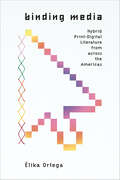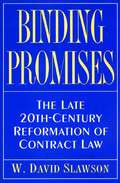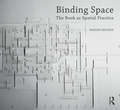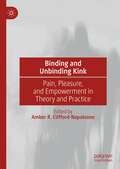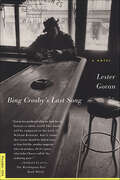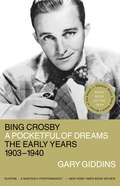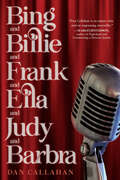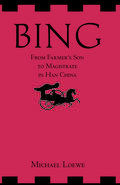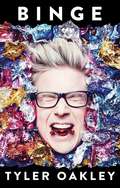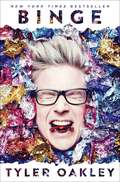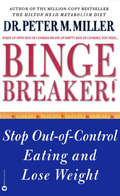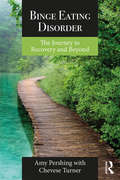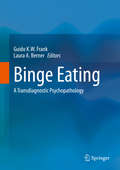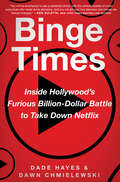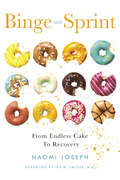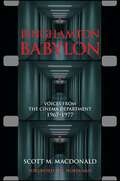- Table View
- List View
Binding Energy of Strongly Deformed Radionuclides: Penning-Trap Mass Spectrometry and Mean-Field Theoretical Studies (Springer Theses)
by Vladimir ManeaThis thesis reports results of precision mass spectrometry of exotic nuclides as a means of elucidating their structure. The work was performed with the ISOLTRAP spectrometer at CERN's ISOLDE facility. The author furthermore offers an overview of existing techniques used in Penning-trap mass spectrometry and also reports on recent promising developments regarding ISOLTRAP. This eloquently written treatment covers both theory and experiment, and includes a general phenomenological introduction to the nuclear-structure intuition contained in the trends of nuclear binding energies.
Binding Media: Hybrid Print-Digital Literature from across the Americas (Stanford Text Technologies)
by Élika OrtegaFar from causing the "death of the book," the publishing industry's adoption of digital technologies has generated a multitude of new works that push the boundaries of literature and its presentation. In this fascinating new work, Élika Ortega proposes the notion of "binding media" — a practice where authors and publishers "fasten together" a codex and electronic or digital media to create literary works in the form of hybrid print-digital objects. Examining more than a hundred literary works from across the Americas, Ortega argues that binding media are not simply experimentations but a unique contemporary form of the book that effectively challenges conventional regional and linguistic boundaries. Furthermore, the book demonstrates that binding media have remained marginal in the publishing industry due to technological imperatives like planned obsolescence and commercial ones like replicability and standardization that run counter to these bespoke literary projects. Although many binding media and other hybrid publishing initiatives have perished, they've left behind a wealth of material; collecting and tracing the residues of these foreshortened projects, Ortega builds a fascinating history of hybrid publishing. Ultimately, this essential account of contemporary book history highlights the way binding media help illuminate processes of cultural hybridization that have been instigated by the expediency of globalized digital technologies and transnational dynamics.
Binding Men: Stories About Violence and Law in Late Victorian England
by Lois S. BibbingsBinding Men tells stories about men, violence and law in late Victorian England. It does so by focusing upon five important legal cases, all of which were binding not only upon the males involved but also upon future courts and the men who appeared before them. The subject matter of Prince (1875), Coney (1882), Dudley and Stephens (1884), Clarence (1888) and Jackson (1891) ranged from child abduction, prize-fighting, murder and cannibalism to transmitting gonorrhoea and the capture and imprisonment of a wife by her husband. Each case has its own chapter, depicting the events which led the protagonists into the courtroom, the legal outcome and the judicial pronouncements made to justify this, as well as exploring the broader setting in which the proceedings took place. In so doing, Binding Men describes how a particular case can be seen as being a part of attempts to legally limit male behaviour. The book is essential reading for scholars and students of crime, criminal law, violence, and gender. It will be of interest to those working on the use of narrative in academic writing as well as legal methods. Binding Men’s subject matter and accessible style also make it a must for those with a general interest in crime, history and, in particular, male criminality.
Binding Phenomena: General Description and Analytical Applications (Physical Chemistry in Action)
by Waldemar A. Marmisollé Dionisio PosadasThis book presents a unified description of binding equilibrium for a wide variety of systems focusing on acid-base and coordination chemistry, adsorption at interfaces, and electron binding in electrochemistry. It overviews more complex phenomena such as competitive binding to different sites and of different ligands. Multiple sites such as those occurring in macromolecules, colloidal oxides, humid substances, and proteins are briefly discussed and many experimental results for these types of systems are analyzed. Titrations and consideration of the distribution of binding constants are also presented. The book is mainly directed at undergraduate/graduate students of chemistry, biology, and earth sciences. It is supplementary to the standard physical and analytical chemistry courses and will help both students and teachers get a more in-depth knowledge and understanding of the systems analyzed.
Binding Promises: The Late 20th-Century Reformation of Contract Law
by W. David SlawsonDuring its classical period, American contract law had three prominent characteristics: nearly unlimited freedom to choose the contents of a contract, a clear separation from the law of tort (the law of civil wrongs), and the power to make contracts without regard to the other party's ability to understand them. Combining incisive historical analysis with a keen sense of judicial politics, W. David Slawson shows how judges brought the classical period to an end about 1960 with a period of reform that continues to this day.American contract law no longer possesses any of the prominent characteristics of its classical period. For instance, courts now refuse to enforce standard contracts according to their terms; they implement the consumer's reasonable expectations instead. Businesses can no longer count on making the contracts they want: laws for certain industries or for businesses generally set many business obligations regardless of what the contracts say. A person who knowingly breaches a contract and then tries to avoid liability is subject to heavy penalties.As Slawson demonstrates, judges accomplished all these reforms, although with some help from scholars. Legislation contributed very little despite its presence in massive amounts and despite the efforts of modern institutions of law reform such as the Conference of Commissioners on Uniform State Laws. Slawson argues persuasively that this comparison demonstrates the superiority of judge-made law to legislation for reforming private law of any kind.
Binding Space: The Book as Spatial Practice (Design Research in Architecture)
by Marian MackenBooks orient, intrigue, provoke and direct the reader while editing, interpreting, encapsulating, constructing and revealing architectural representation. Binding Space: The Book as Spatial Practice explores the role of the book form within the realm of architectural representation. It proposes the book itself as another three-dimensional, complementary architectural representation with a generational and propositional role within the design process. Artists’ books in particular – that is, a book made as an original work of art, with an artist, designer or architect as author – have certain qualities and characteristics, quite different from the conventional presentation and documentation of architecture. Paginal sequentiality, the structure and objecthood of the book, and the act of reading create possibilities for the book as a site for architectural imagining and discourse. In this way, the form of the book affects how the architectural work is conceived, constructed and read. In five main sections, Binding Space examines the relationships between the drawing, the building and the book. It proposes thinking through the book as a form of spatial practice, one in which the book is cast as object, outcome, process and tool. Through the book, we read spatial practice anew.
Binding Their Wounds: America's Assault on Its Veterans
by Robert J. Topmiller T. Kirby NeillThe victims of US military campaigns are usually nameless civilians in far away places, but there are also victims closer to home - the soldiers so often used and then discarded by the establishment. Binding Their Wounds is a book about US veterans written by a US veteran - Bob 'Doc' Topmiller. Topmiller fought in Vietnam, founded a school for orphans there, and become a professor of history before he tragically committed suicide. Close friend and scholar Kerby Neill stepped in to complete the book. The result is a history of US veterans and their treatment by the US establishment from the early republic to the recent wars in Iraq and Afghanistan. Binding Their Wounds offers policy recommendations to improve post-conflict treatment and care for veterans which are long overdue.
Binding Up the Wounds: An American Soldier in Occupied Germany, 1945--1946
by Leon C. StandiferIn his highly acclaimed Not in Vain, Leon C. Standifer recounted his experiences as a small-town Mississippi boy who at age nineteen found himself fighting as a combat infantryman in World War II France and Germany. Binding up the Wounds carries the story beyond V-E Day to describe what the author saw, heard, felt, and learned as a member of the American occupation army in the homeland of its defeated enemy.Standifer, who served in the 94th Infantry Division in western Germany, the Sudetenland, and Bavaria in the first year of occupation, chronicles that unique and chaotic time from the viewpoint of a typical GI. Germany was an epic landscape of human need, and cities lay in ruins. But the war was over, light and laughter were once again possible, and, as Standifer recalls, "we had a ball during that first year." Among the things he experienced or witnessed were black-market operations large and small (American cigarettes served as a universal currency, and a few ounces of mess-hall grease or used coffee grounds were valuable commodities); the spectacle of gung-ho officers attempting to turn combat troops into spit-and-polish paraders; the exploitive games played between American soldiers and German women; a gut-wrenching visit to a displaced persons camp; and the difficulties involved in guarding captured soldiers who were no longer the enemy.Perhaps most revealing, and often surprising, are the attitudes Standifer discovered among ordinary Germans toward the war, the Nazis, the "Hitler times" in general-not only during the occupation, but also decades later when he revisited Germany and spoke with elderly survivors of those times. For there are really two voices telling the tale of Binding Up the Wounds. One is that of the combat-hardened but otherwise naive twenty-year-old who lived the experiences. The other is that of the author as retired college professor looking back over half a century and puzzling out what those experiences meant for himself, for America, and for humankind.
Binding and Unbinding Kink: Pain, Pleasure, and Empowerment in Theory and Practice
by Amber R. Clifford-NapoleoneThis book is a collection of essays highlighting different disciplinary, topical, and practical approaches to the study of kink and popular culture. The volume is written by both academics and practitioners, bringing the essays a special perspective not seen in other volumes. Essays included examine everything from Nina Hartley fan letters to kink shibari witches to kink tourism in a South African prison. The focus is not just on kink as a sexual practice, but on kink as a subculture, as a way of living, and as a way of seeing popular culture in new and interesting ways.
Binding: A Special Issue of Visual Cognition
by James R. Brockmole Steven L. FranconeriVisual processing acts as a prism, splitting visual information from the retinal image into separately processed features such as color, shape, and orientation. Binding refers to the set of cognitive and neural mechanisms that re-integrate these features to create a holistic representation of the objects in the visual field. The binding problem in vision refers to how this integration is achieved. The binding problem, however, isnâe(tm)t a singular problem, but a constellation of interrelated problems. The articles in this special issue of Visual Cognition cover three major types of binding, each of which may require a unique solution: The binding of features within objects, the relational binding among objects, and the binding between temporally related events. Within these broad topics, articles consider the role of attention in feature binding, the representation of static and moving multi-feature objects, the binding of objects to scenes, binding processes involved in learning and long-term memory, the development of binding abilities, and binding of information between visual and non-visual memory systems. Rather than disseminate conclusive solutions to these various instantiations of the binding problem, this collection of work describes the current state-of-the science, highlights the interconnections between the binding problems and the approaches taken to solve them, and outlines the critical issues that have yet to be resolved. In this single volume readers will confront work with children, young adults, and patients, and work that uses traditional behavioural measures, eye movement recording, functional imaging, and transcranial magnetic stimulation.
Bindungsorientierte Elternberatung
by Beth TroutmanDieses Buch untersucht bindungsorientiertes Elterncoaching zur Bewältigung emotionaler und Verhaltensprobleme bei Kleinkindern. Der Band fasst relevante Forschung zur Entwicklungs- und Bindungstheorie zusammen und beschreibt, wie diese einen bindungsorientierten Coaching-Ansatz unterstützt. Das Buch thematisiert die Herausforderungen der Erziehung von Kleinkindern mit auffälligem Verhalten oder emotionaler Reaktivität und wie psychische Gesundheitsanbieter Eltern helfen können, diese Herausforderungen anzugehen. Die Kapitel beschreiben, wie Therapeuten ihre Beobachtungen von Eltern und Kindern nutzen können, um das Elterncoaching an verschiedene Bindungsmuster von Kindern und Erwachsenen anzupassen. Es wird die wichtige Rolle der Erwachsenenbindung bei der Anpassung des Elterncoachings diskutiert, einschließlich des Verständnisses, wie das Arbeitsmodell von TherapeutInnen die Arbeit mit Familien beeinflusst. Jedes Kapitel enthält Informationen zu aktueller Forschung sowie reichhaltige Beispiele, wie diese Forschung die klinische Praxis bereichern kann. Wichtige Themen sind: Die Rolle der Erwachsenenbindung in der Arbeit mit Kleinkindern. Umgang mit sicheren, ambivalenten/widerständigen, vermeidenden, desorganisierten und kontrollierenden Kind-Eltern-Dyaden. Coaching von Eltern mit sicherem, erarbeitet sicherem, besorgtem, abweisendem oder ungelöstem Bindungsverständnis. Arbeit mit adoptierten Kindern sowie Kindern in Pflegefamilien. Dieses Buch ist eine unverzichtbare Ressource für ForscherInnen, ProfessorInnen und Graduiertenstudierenden sowie für KlinikerInnen und Fachleute in der Entwicklungspsychologie, Sozialarbeit, Pädiatrie, Familienforschung, Pflege, Kinderpsychiatrie, Ergotherapie und frühkindlicher Erziehung.
Bing Crosby's Last Song: A Novel
by Lester GoranA novel by the author of The New York Times Notable Book, Tales from the Irish ClubIt is June 1968: Robert Kennedy has just been murdered, the streets are simmering with discontent, and the Irish community of Oakland Park in Pittsburgh is being swept away by change. Daly Racklin becomes the reluctant leader of a dying neighborhood, culture, and people. He is at once a man torn by his father's omnipotent shadow and the struggles of his own heart, and as his elevated position brings him from one home to another he increasingly discovers the importance of what he sees disappearing. Bing Crosby's Last Song is a hilarious, touching, heartwrenching story of survival and love, a community's demise and a wanderer's rebirth. Full of barroom lore, hard-bitten wisdom, wry humor, and faith tempered by skepticism, this novel will delight readers of William Kennedy and Frank McCourt.
Bing Crosby: A Pocketful of Dreams, The Early Years 1903 - 1940
by Gary GiddinsFrom 1934 to 1954, Bing Crosby utterly dominated North American entertainment. Nobody has ever had as many hit records, and Crosby was the number one movie star five years in a row. The rise of Bing Crosby was the rise of North American popular culture itself. In Bing Crosby, the first volume of the definitive Crosby biography, award-winning music critic Gary Giddins chronicles the ascension of Bing's career. From Crosby's early recordings, to his triumph on Americas most popular radio show, to his first success in Hollywood, Giddins provides the most detailed study yet of the rise of a North American star. This is the first definitive biography of Crosby and was written with exclusive access to unpublished materials. Giddins Visions of Jazz won the 1998 National Book Critics Circle Award. Bing Crosby was the first North American pop culture icon, and his career heavily influenced Sinatra and Elvis, as well as popular music itself.
Bing Crosby: Swinging on a Star: The War Years, 1940-1946
by Gary Giddins"The best thing to happen to Bing Crosby since Bob Hope," (WSJ) Gary Giddins presents the second volume of his masterful multi-part biography Bing Crosby dominated American popular culture in a way that few artists ever have. From the dizzy era of Prohibition through the dark days of the Second World War, he was a desperate nation's most beloved entertainer. But he was more than just a charismatic crooner: Bing Crosby redefined the very foundations of modern music, from the way it was recorded to the way it was orchestrated and performed. In this much-anticipated follow-up to the universally acclaimed first volume, NBCC Winner and preeminent cultural critic Gary Giddins now focuses on Crosby's most memorable period, the war years and the origin story of White Christmas. Set against the backdrop of a Europe on the brink of collapse, this groundbreaking work traces Crosby's skyrocketing career as he fully inhabits a new era of American entertainment and culture. While he would go on to reshape both popular music and cinema more comprehensively than any other artist, Crosby's legacy would be forever intertwined with his impact on the home front, a unifying voice for a nation at war. Over a decade in the making and drawing on hundreds of interviews and unprecedented access to numerous archives, Giddins brings Bing Crosby, his work, and his world to vivid life--firmly reclaiming Crosby's central role in American cultural history.
Bing and Billie and Frank and Ella and Judy and Barbra
by Dan CallahanCrosby, Holiday, Sinatra, Fitzgerald, Garland, and Streisand were the major interpreters of the American songbook, and this is the interlocking story of their lives and careers. Here is the epic tale of how these artists dominated American popular music over a fifty-year period, a roller coaster ride that gains momentum through the 1930s and '40s, reaches a crest of magical creativity in the 1950s and early '60s, and then crashes down by the early 1970s, a half century when the great American songbook dominated the airwaves and the fight for racial equality came to the forefront. Ella was beloved in her time, and she is still beloved. Frank is still the king of the songbook, but Bing's legacy is just as vital once you start listening to his unprecedented 1930s output. The best songs from Judy's greatest triumph, her 1963–64 TV series, are shared endlessly online. The legend of Billie grows by the year, and the basis of this should be appreciation and wonder for her own great artistry in the 1930s. Barbra is a living legend and still a commercial force to be reckoned with, the last exemplar of the songbook and its glories. All six of these singers reach out to us and show us new ways of expression and new ways to dream.Their song is largely ended but the melody lingers on.
Bing: From Farmer's Son to Magistrate in Han China
by Michael LoeweMuch is known of life during the Han Empire, but the historical evidence remains fragmentary, and nowhere do we find a continuous account of the life of any one individual.In this engaging volume, Michael Loewe mines the written and material records to depict the imagined life of an ordinary person, Bing Wu, from the hardships of his earliest years on a rural farm to his retirement from a respected position in government service. Underlying the tale of Bing is a richly detailed portrait of life during the Han--the arduous tasks of the conscript laborer; military service on the defense lines of the north; the travels of a merchant; the grueling conditions in an iron foundry; the construction of tombs; preparations for entering the civil service; the duties of a junior clerk and the governing of a commandery. Along the way, we are introduced to the operation of a crossbow; methods of telling time; the practice of writing; the rituals of divination; the ceremony of a state occasion, laws and the harsh consequences of breaking them; the workings of the central government and much more.Included are a concise introduction, explanatory endnotes to each chapter, a selection of illustrations, a map of the Han Empire, notes for further reading and an essay by Loewe entitled, "A Brief History of the Han Empire."
Binge
by Tyler OakleyFor someone who made a career out of over-sharing on the internet, Tyler Oakley has a shocking number of personal mishaps and shenanigans to reveal in his first book: he experienced a legitimate rage blackout in a Cheesecake Factory; he had a fashion stand-off with the White House secret service; he crashed a car in front of his entire high school in his fast food restaurant server's uniform; he projectile vomited while bartering with a grandmother. With millions of fans clamouring for more Tyler Oakley, he delivers his best untold, hilariously side-splitting moments with trademark flair in Binge.
Binge
by Tyler OakleyPop-culture phenomenon, social rights advocate, and the most prominent LGBTQ+ voice on YouTube, Tyler Oakley brings you Binge, his New York Times bestselling collection of witty, personal, and hilarious essays.For someone who made a career out of over-sharing on the Internet, Tyler has a shocking number of personal mishaps and shenanigans to reveal in his first book: experiencing a legitimate rage blackout in a Cheesecake Factory; negotiating a tense standoff with a White House official; crashing a car in front of his entire high school, in an Arby’s uniform; projectile vomiting while bartering with a grandmother; and so much more. In Binge, Tyler delivers his best untold, hilariously side-splitting moments with the trademark flair that made him a star.
Binge Breaker! Stop Out-of-Control Eating and Lose Weight: Stop Out-of-Control Eating and Lose Weight
by Peter M. MillerBinge eating, eating more food than feels comfortable, is a problem for more than half of all overweight North Americans. Binge eating is not bulimia, and while many do it, over the sink, late at night, or in front of the refrigerator, yo-yo dieters are especially susceptible. Renowned diet expert Dr. Peter M. Miller reveals the proven six-step program that has already helped thousands of dieters conquer binge eating and lose weight permanently.
Binge Eating Disorder: The Journey to Recovery and Beyond
by Amy Pershing Chevese TurnerBinge Eating Disorder, written by a clinician and an advocate who have personally struggled with Binge Eating Disorder (BED), illuminates the experience of BED from the patient perspective while also exploring the disorder’s etiological roots and addressing the components of treatment that are necessary for long-term recovery. Accessible for both treatment providers and patients alike, this unique volume aims to explore BED treatment and recovery from both sides of the process while also providing a resource for structuring treatment and building effective interventions. This practical roadmap to understanding, resilience, and lasting change will be useful for anyone working clinically with or close to individuals suffering from BED, as well as those on the recovery journey.
Binge Eating: A Transdiagnostic Psychopathology
by Guido K. W. Frank Laura A. BernerThis book provides a comprehensive overview of our current understanding of binge eating, which is characterized by the uncontrollable consumption of large amounts of food in a discrete time period. Written by experts on eating disorders, it first introduces the phenotype of binge eating, including its epidemiology and assessment. It then describes the underlying neurobiological alterations, drawing on cutting-edge animal models and human studies to do so. In addition, it extensively discusses current treatment models, including medication, psychotherapy, self-interventions and disease prevention. Lastly, an outlook on the future research agenda rounds out the coverage. Given binge eating’s current status as an under-researched symptom, but one shared across many eating disorders, this book provides an up-to-date, integrative and comprehensive synthesis of recent research and offers a valuable reference for scientists and clinicians alike.
Binge Times: Inside Hollywood's Furious Billion-Dollar Battle to Take Down Netflix
by Dade Hayes Dawn ChmielewskiThe first comprehensive account of the biggest wake-up call in the history of the entertainment business: the pivot to streaming. Go inside a disparate group of media and tech companies -- Disney, Apple, AT&T/WarnerMedia, Comcast/NBCUniversal and well-funded startup Quibi – as they scramble to mount multi-billion-dollar challenges to Netflix.After spotting Netflix and the deep-pocketed Amazon Prime Video a decade’s head start, rivals from the tech and start-up realm (Apple, Quibi) and traditional media (Disney, WarnerMedia, NBCUniversal) all decided to move mountains to enter the streaming game. At a cost of billions, each went after their own piece of the market, launching five new services in a seven-month span. And just as the derby was heating up, the coronavirus pandemic arrived, a black-swan event bringing short-term benefits but also stiff challenges.The battle for streaming supremacy may end up having more than one winner, but the cost and disruption to decades-old business models have also produced a lot of losers. Binge Times reveals the true costs of the vision quest as companies are turned inside-out and repeatedly redraw their org charts and strategic plans. Stretching from Silicon Valley to Hollywood to Wall Street, it is a mesmerizing, character-rich tale of hubris and ambition, as the fate of a century-old industry hangs in the balance.
Binge and Sprint: From Endless Cake to Recovery
by Naomi JosephHave you ever stood at the kitchen counter urgently devouring insane amounts of frozen, stale hot dog buns dipped alternatively in jelly and almond butter, while on high alert for approaching humans? After a lifetime of getting knocked to the ground by the same opponent, a Dark Voice, and then rising repeatedly while praying for a way out, Naomi Joseph wrote the rules of "Binge and Sprint:" Use cake as fortitude to steel yourself to plow ahead, and then keep moving, keep achieving, and never ever let the world see your suffering. Never idle, Joseph takes the reader on a four decade journey from childhood through college, marriage, buying a home, comparison, community, infertility, low self-worth, work, starting a business, keeping up with the Joneses, and caring for children and ailing parents, all while chained to her secret burden. Readers will understand their own darkness in the midst of "the good life" as the lid is blown off the hameful shroud of the taboo war with food.Poignant and hilarious, Josesph's journey will help the reader claim their power, and lean into their greatness as they incorporate the many lessons that brought her to recovery into their own lives.
Binge-Eating Disorder
by James Mitchell Michael DevlinThis innovative scientific reference and clinical tool is virtually two books in one. Part I thoroughly yet succinctly reviews the literature on binge-eating disorder, covering diagnosis and epidemiology, clinical features and course, links to obesity, medical risks, and current treatment data. Part II provides an evidence-based cognitive-behavioral treatment manual. Session-by-session guidelines address how to help individuals or groups change their eating behavior, cope with emotional triggers, restructure problematic thoughts, deal with body image concerns and associated problems, maintain improvement, and prevent relapse. Featured are more than 40 clearly explained homework assignments and handouts, all in a large-size format with permission to photocopy.
Binghamton Babylon: Voices from the Cinema Department, 1967-1977 (SUNY series, Horizons of Cinema)
by Scott M. MacDonaldIn Binghamton Babylon, Scott M. MacDonald documents one of the crucial moments in the history of cinema studies: the emergence of a cinema department at what was then the State University of New York at Binghamton (now Binghamton University) between 1967 and 1977. The department brought together a group of faculty and students who not only produced a remarkable body of films and videos but went on to invigorate the American media scene for the next half-century. Drawing on interviews with faculty, students, and visiting artists, MacDonald weaves together an engaging conversation that explores the academic excitement surrounding the emergence of cinema as a viable subject of study in colleges and universities. The voices of the various participants—Steve Anker, Alan Berliner, Danny Fingeroth, Hollis Frampton, Ernie Gehr, J. Hoberman, Ralph Hocking, Ken Jacobs, Bill T. Jones, Peter Kubelka, Saul Levine, Camille Paglia, Phil Solomon, Maureen Turim, and many others—tell the story of this remarkable period. MacDonald concludes with an analysis of the pedagogical dimensions of the films that were produced in Binghamton, including Larry Gottheim's Horizons; Jacobs's Tom, Tom, the Piper's Son; Gehr's Serene Velocity; Frampton's Critical Mass; and Nicholas Ray's final film, We Can't Go Home Again.

